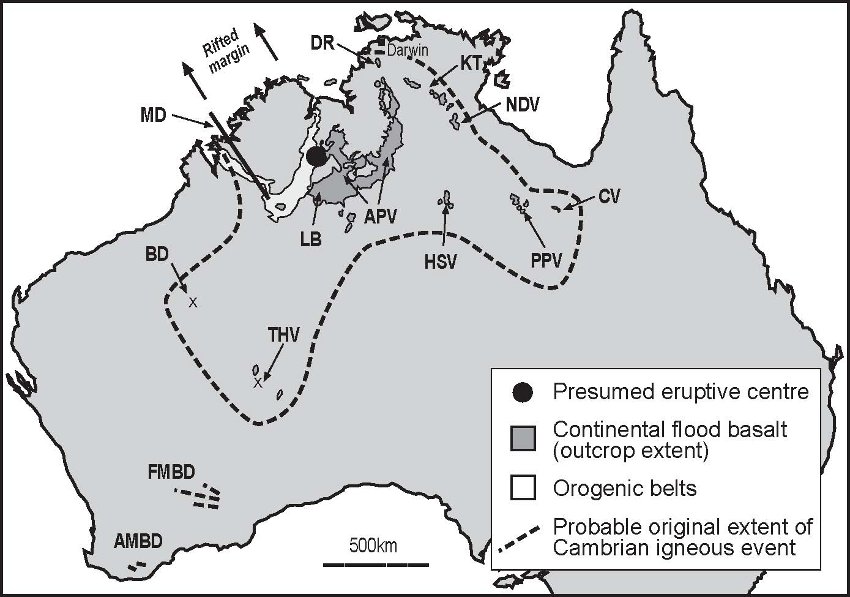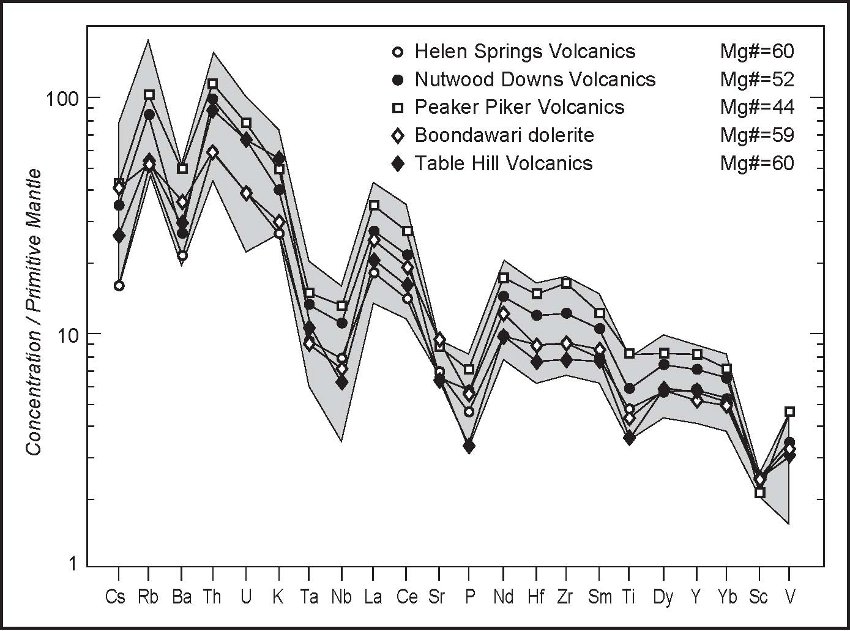October 2006 LIP of the Month
Corresponds to event #49 in LIP record database (see also October 2005 LIP of the Month).
The Kalkarindji Continental Flood Basalt Province: A new Large Igneous Province in Australia
Linda Glass
Northern Territory Geological Survey, Department of Primary Industry, Fisheries and Mines Centrepoint Building Smith Street Mall GPO Box 3000 DARWIN NT 0801 AUSTRALIA
linda.glass@nt.gov.au
The Kalkarindji continental flood basalt province is the suggested new stratigraphic name (Glass & Phillips, 2006) for a number of scattered basalt suites across northern and central Australia, including the sub-aerial Antrim Plateau Volcanics (minimum volume of 0.15 x 106 km3) and intrusive Milliwindi dolerite dyke in the north, and the stratigraphically correlated Nutwood Downs, Helen Springs, Peaker Piker and Colless Volcanics in the east (Dunn, 1963; Bultitude, 1976; Hanley and Wingate, 2000). The name was chosen to avoid confusion with the well-known Antrim basalts of the British Tertiary Igneous Province and to provide a definitive link between correlative igneous suites. This vast Cambrian igneous event is Australia’s oldest and largest Phanerozoic large igneous province. Recent aerial magnetic imagery across northern Australia, reveals the presence of extensive basalt sub-crops under Palaeozoic and Mesozoic cover, with flows up to 200 km long, filling palaeo-valley and stratigraphic lows. The province thus extends across a vast area (>106 km2) (Fig. 1), with maximum thickness attained in the north-western part of the province within the Antrim Plateau Volcanics (~1500m; Mory and Beere, 1988). The original pre-erosion volume of the province is difficult to estimate, although it is likely to have exceeded 5x105 km3 (based on an areal extent of >1 x 106 km2 and an average thickness of ~0.5 km).

Figure 1: Schematic map showing outcrop areas of the Antrim Plateau Volcanics and stratigraphic equivalents. APV = Antrim Plateau Volcanics; HSV = Helen Springs Volcanics and sample HS002; PPV = Peaker Piker Volcanics; CV = Colless Volcanics; NDV = Nutwood Downs Volcanics; MD = Milliwindi dolerite; BD = Boondawari dolerite; THV = Table Hill Volcanics; LB = sample LB011; DR = sample DR021; KT = sample KT001; FMBD = Fraser Mobile Belt dolerite; AMBD = Albany Mobile Belt dolerite.
The Antrim Plateau basalts typically comprise ~20-60m (up to 200 m) thick lava flows of mostly aphanitic massive basalt with vesicular or brecciated flow tops, and less common plagioclase-phyric porphyritic basalt. Glomeroporphyritic, often columnar-jointed and hydrothermally altered basalts occur locally in the west. Individual basalt flows may be intercalated with thin beds of aeolian sandstone, conglomerate, siltstone and stromatolitic chert (Randal and Brown, 1967); however, age-diagnostic fossils have yet to be found (Bultitude, 1976).
Stratigraphic constraints suggest the Kalkarindji volcanics are at least Middle Cambrian in age (>500 Ma; Kruse et al., 1994; Bowring and Erwin, 1998) consistent with the oldest previous K-Ar ages for Antrim Plateau and Helen Springs basalt samples of ca. 510 Ma (Bultitude, 1976) and with a recent SHRIMP U-Pb zircon age of 513 ± 12 Ma for the related Milliwindi dolerite (Hanley and Wingate, 2000).
In western-central Australia, the Boondawari dolerite, located within the large Neoproterozoic to Palaeozoic Officer Basin (Figure 1) has been dated at 508 ± 10 Ma (2σ), using the U-Pb zircon method (Macdonald et al., 2005). Age constraints for the Table Hill Volcanics in the south (Fig. 1), include a Rb-Sr result of 575 ± 40 Ma (Compston, 1974) and K-Ar whole rock ages of 500 ± 14 Ma (2σ; Veevers, 2000) and 484 ± 8 Ma (2σ; Stevens and Apak, 1999), the latter being in the Ordovician.
Recent high precision 40Ar/39Ar analyses of plagioclase feldspar separates from basalt flows yield ages of 508 ± 2 Ma and 505 ± 2 Ma (2σ), indistinguishable from previous U-Pb zircon ages for related dolerites (Glass & Phillips, 2006).
The basalts are low-Ti tholeiites and are geochemically distinctive having unusual elevated incompatible element signatures (high Th/U, La/Sm, Rb/Ba) Figure 2. Results from 80 Antrim Plateau samples, spanning an Mg# range of 34-72 are compared with data for representative samples from the northern and western-central Australian stratigraphic equivalents. The stratigraphic correlatives are geochemically indistinguishable from the Antrim Plateau Volcanics, with near constant trace element ratios (e.g. Ba/Th, Nb/La and P/Nd), indicating a common parentage. However, for the Table Hill Volcanics, abundances of the highly incompatible elements Rb and Cs, are likely affected by alteration.

Figure 2: Primitive-mantle normalised element abundance diagram for Antrim Plateau Volcanics (shaded area) and stratigraphic equivalents Helen Springs Volcanics – HS002; Nutwood Downs Volcanics – ND002; Peaker Piker Volcanics – PP004, Boondawari sill - BD001 and Table Hill Volcanics -TH002. (Normalising values from McDonough and Sun, 1995). [Mg# = 100*molar MgO/(MgO+FeO), for Fe2O3/FeO = 0.15]. Modified from Glass (2002).
Relative to mid-ocean ridge basalts, the Kalkarindji province is characterised by low FeOtotal and TiO2 contents at fixed Mg# (e.g. at Mg#65, FeOtotal ~8.4 wt% and TiO2 ~0.8 wt%). Compared to most other continental flood basalts worldwide, the Kalkarindji basalts are distinguished by low HFSE abundances (Ti, P, Nb) relative to the incompatible elements and extreme enrichment in the most incompatible elements, such as Th, U and LREE (Glass, 2002). The distinctive Low-Ti and incompatible element enriched geochemical signature is far removed from typical tholeiitic basalts and implies crustal involvement in the genesis of the Kalkarindji basalts. A detailed geochemical and isotopic study involving petrogenetic modelling of the basalts will be the focus of a manuscript to be published in the near future.
REFERENCES CITED
Bowring, S. A., and Erwin, D. H., 1998, A new look at evolutionary rates in deep time; uniting paleontology and high-precision geochronology: GSA Today, v. 9, p. 1-8.
Bultitude, R. J., 1976, Flood basalts of probable early Cambrian age in northern Australia, in Johnson, R.W., ed., Volcanism in Australia: New York, USA, Elsevier Science, p. 1-20.
Compston, W., 1974, The Table Hill Volcanics of the Officer Basin – Precambrian or Palaeozoic? Journal of the Geological Society of Australia, v. 21(4), p. 403-411.
Dunn, P. R., 1963, Hodgson Downs, Northern Territory, in 1:250 000 Geological Series, sheet SD/53-14: Bureau of Mineral Resources.
Glass, L. M., 2002, Petrogenesis and Geochronology of the North Australian Kalkarinji Low-Ti Continental Flood Basalt Province: unpublished PhD thesis, The Research School of Earth Sciences, The Australian National University, Canberra, Australia, 325p.
Glass, L.M. & Phillips, D., 2006. The Kalkarindji continental flood basalt province: A new Cambrian large igneous province in Australia with possible links to faunal extinctions. Geology, v 34 (6), P. 461-464.
Hanley L.M., and Wingate M.T.D., 2000, SHRIMP zircon age for an Early Cambrian dolerite dyke: an intrusive phase of the Antrim Plateau Volcanics of northern Australia: Australian Journal of Earth Sciences, v. 47, p. 1029-1040.
Kruse, P. D., Sweet, I. P., Stuart-Smith, P. G., Wygralak, A. S., Pieters, P. E., and Crick, I. H., 1994, Katherine SD53-9. in 1250,000 Geological map series, explanatory notes: Department of Mines and Energy, Northern Territory Geological Survey.
Macdonald, F.A., Wingate, M.T.D., and Mitchell, K., 2005, Geology and age of the Glikson impact structure, Western Australia: Australian Journal of Earth Sciences, v. 52 (in press).
McDonough, W. F., and Sun, S.-s., 1995, The composition of the Earth: Chemical Geology v. 120, p. 223-253.
Mory, A. J., and Beere, G. M., 1988, Geology of the onshore Bonaparte and Ord Basins in Western Australia. Bulletin, v. 134, p. 184.
Randal, M. A., and Brown, M. C., 1967, The Geology of the northern part of the Wiso Basin, N.T. in Geology and Geophysics, Record 1967/110, Bureau of Mineral Resources, 125p.
Stevens, M.K., and Apak, S.N., 1999, GSWA Empress 1 and 1A well completion report, Yowalga Sub-basin, Officer Basin, Western Australia: Geological Survey, annual Review for 1996-1997, p. 55-60.
Veevers J.J., 2000, Neoproterozoic Australia, in Veevers, J.J., ed., Billion-year old earth history of Australia and neighbours in Gondwanaland: GEMOC Press, 388p.
